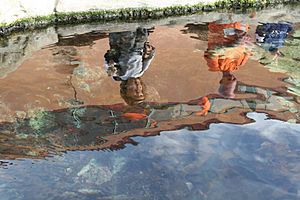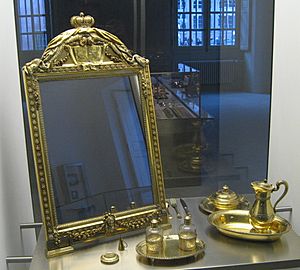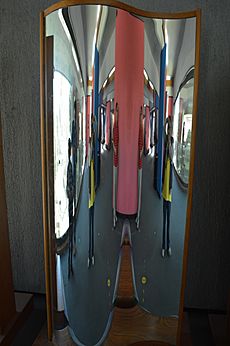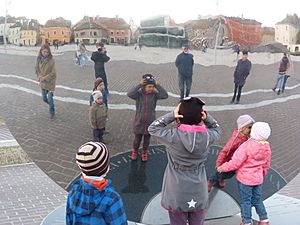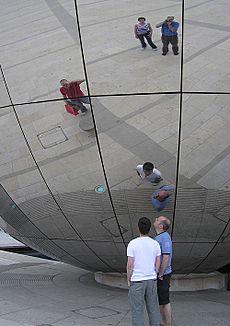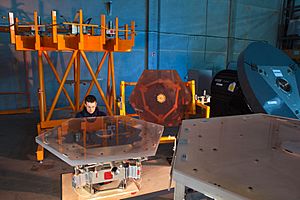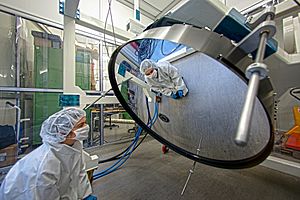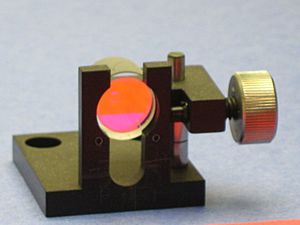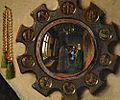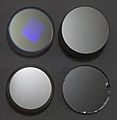Mirror facts for kids
A mirror or looking-glass is something that reflects light. One common plane mirror is a piece of special flat glass that a person can look into to see a reflection of themselves or what is behind them.
Sometimes, a flat piece of metal or the surface of water can act like a mirror.
The reason you are able to see yourself in a mirror is because light comes in and gets reflected, and that's how you are able to see your reflection.
Mirrors can have magnification properties, making images appear smaller or larger than their actual size. They can also be concave (curved inward) or convex (curved outward), making the reflected angle and view to be smaller or larger, respectively. Special mirrors can make a person's appearance look quite strange.
Also, in a mirror, writing appears backwards, as a "mirror image" of the original writing.
Mirrors are usually made out of glass with metal on the back, called "silvering" even if the metal is not silver. Some mirrors are made of polished metal, which is less breakable.
Mirrors with a curved surface can make things appear bigger or smaller, like a lens does.
Contents
Types of glass mirrors
There are many types of glass mirrors, each representing a different manufacturing process and reflection type.
An aluminium glass mirror is made of a float glass manufactured using vacuum coating, i.e. aluminium powder is evaporated (or "sputtered") onto the exposed surface of the glass in a vacuum chamber and then coated with two or more layers of waterproof protective paint.
A low aluminium glass mirror is manufactured by coating silver and two layers of protective paint on the back surface of glass. A low aluminium glass mirror is very clear, light transmissive, smooth, and reflects accurate natural colors. This type of glass is widely used for framing presentations and exhibitions in which a precise color representation of the artwork is truly essential or when the background color of the frame is predominantly white.
A safety glass mirror is made by adhering a special protective film to the back surface of a silver glass mirror, which prevents injuries in case the mirror is broken. This kind of mirror is used for furniture, doors, glass walls, commercial shelves, or public areas.
A silkscreen printed glass mirror is produced using inorganic color ink that prints patterns through a special screen onto glass. Various colors, patterns, and glass shapes are available. Such a glass mirror is durable and more moisture resistant than ordinary printed glass and can serve for over 20 years. This type of glass is widely used for decorative purposes (e.g., on mirrors, table tops, doors, windows, kitchen chop boards, etc.).
A silver glass mirror is an ordinary mirror, coated on its back surface with silver, which produces images by reflection. This kind of glass mirror is produced by coating a silver, copper film and two or more layers of waterproof paint on the back surface of float glass, which perfectly resists acid and moisture. A silver glass mirror provides clear and actual images, is quite durable, and is widely used for furniture, bathroom and other decorative purposes.
Decorative glass mirrors are usually handcrafted. A variety of shades, shapes and glass thickness are often available.
Effects
Shape of a mirror's surface
A beam of light reflects off a mirror at an angle of reflection equal to its angle of incidence (if the size of a mirror is much larger than the wavelength of light). That is, if the beam of light is shining on a mirror's surface, at a  ° angle vertically, then it reflects from the point of incidence at a
° angle vertically, then it reflects from the point of incidence at a  ° angle from vertically in the opposite direction. This law mathematically follows from the interference of a plane wave on a flat boundary (of much larger size than the wavelength).
° angle from vertically in the opposite direction. This law mathematically follows from the interference of a plane wave on a flat boundary (of much larger size than the wavelength).
- In a plane mirror, a parallel beam of light changes its direction as a whole, while still remaining parallel; the images formed by a plane mirror are virtual images, of the same size as the original object (see mirror image).
- In a concave mirror, parallel beams of light become a convergent beam, whose rays intersect in the focus of the mirror. Also known as converging mirror
- In a convex mirror, parallel beams become divergent, with the rays appearing to diverge from a common point of intersection "behind" the mirror.
- Spherical concave and convex mirrors do not focus parallel rays to a single point due to spherical aberration. However, the ideal of focusing to a point is a commonly used approximation. Parabolic reflectors resolve this, allowing incoming parallel rays (for example, light from a distant star) to be focused to a small spot; almost an ideal point. Parabolic reflectors are not suitable for imaging nearby objects because the light rays are not parallel.
Mirror image
Objects viewed in a (plane) mirror will appear laterally inverted (e.g., if one raises one's right hand, the image's left hand will appear to go up in the mirror), but not vertically inverted (in the image a person's head still appears above his body). However, a mirror does not usually "swap" left and right any more than it swaps top and bottom. A mirror typically reverses the forward/backward axis. To be precise, it reverses the object in the direction perpendicular to the mirror surface (the normal). Because left and right are defined relative to front-back and top-bottom, the "flipping" of front and back results in the perception of a left-right reversal in the image. (If you stand side-on to a mirror, the mirror really does reverse your left and right, because that's the direction perpendicular to the mirror.)
Looking at an image of oneself with the front-back axis flipped results in the perception of an image with its left-right axis flipped. When reflected in the mirror, your right hand remains directly opposite your real right hand, but it is perceived as the left hand of your image. When a person looks into a mirror, the image is actually front-back reversed, which is an effect similar to the hollow-mask illusion. Notice that a mirror image is fundamentally different from the object and cannot be reproduced by simply rotating the object.
For things that may be considered as two-dimensional objects (like text), front-back reversal cannot usually explain the observed reversal. In the same way that text on a piece of paper appears reversed if held up to a light and viewed from behind, text held facing a mirror will appear reversed, because the observer is behind the text. Another way to understand the reversals observed in images of objects that are effectively two-dimensional is that the inversion of left and right in a mirror is due to the way human beings turn their bodies. To turn from viewing the side of the object facing the mirror to view the reflection in the mirror requires the observer to look in the opposite direction. To look in another direction, human beings turn their heads about a vertical axis. This causes a left-right reversal in the image but not an up-down reversal. If a person instead turns by bending over and looking at the mirror image between his/her legs, up-down will appear reversed but not left-right. This sort of reversal is simply a change relative to the observer and not a change intrinsic to the image itself, as with a three-dimensional object.
Applications

Personal grooming
Mirrors are commonly used as aids to personal grooming. They may range from small sizes, good to carry with oneself, to full body sized; they may be handheld, mobile, fixed or adjustable. A classic example of the latter is the cheval glass, which may be tilted.
Safety and easier viewing
- Convex mirrors
- Convex mirrors provide a wider field of view than flat mirrors, and are often used on vehicles, especially large trucks, to minimize blind spots. They are sometimes placed at road junctions, and corners of sites such as parking lots to allow people to see around corners to avoid crashing into other vehicles or shopping carts. They are also sometimes used as part of security systems, so that a single video camera can show more than one angle at a time. . Convex mirrors as decoration are used in interior design to provide a predominantly experiential effect.
- Mouth mirrors or "dental mirrors"
- Mouth mirrors or "dental mirrors" are used by dentists to allow indirect vision and lighting within the mouth. Their reflective surfaces may be either flat or curved. Mouth mirrors are also commonly used by mechanics to allow vision in tight spaces and around corners in equipment.
- Rear-view mirrors
- Rear-view mirrors are widely used in and on vehicles (such as automobiles, or bicycles), to allow drivers to see other vehicles coming up behind them. On rear-view sunglasses, the left end of the left glass and the right end of the right glass work as mirrors.
One-way mirrors and windows
- One-way mirrors
- One-way mirrors (also called two-way mirrors) work by overwhelming dim transmitted light with bright reflected light. A true one-way mirror that actually allows light to be transmitted in one direction only without requiring external energy is not possible as it violates the second law of thermodynamics: if one placed a cold object on the transmitting side and a hot one on the blocked side, radiant energy would be transferred from the cold to the hot object. Thus, though a one-way mirror can be made to appear to work in only one direction at a time, it is actually reflective from either side.
- One-way windows
- One-way windows can be made to work with polarized light in the laboratory without violating the second law. This is an apparent paradox that stumped some great physicists, although it does not allow a practical one-way mirror for use in the real world. Optical isolators are one-way devices that are commonly used with lasers.
Signalling
With the sun as light source, a mirror can be used to signal by variations in the orientation of the mirror. The signal can be used over long distances, possibly up to 60 kilometres (37 mi) on a clear day. This technique was used by Native American tribes and numerous militaries to transmit information between distant outposts.
Mirrors can also be used for search to attract the attention of search and rescue helicopters. Specialized type of mirrors are available and are often included in military survival kits.
Technology
Televisions and projectors
Microscopic mirrors are a core element of many of the largest high-definition televisions and video projectors. A common technology of this type is Texas Instruments' DLP. A DLP chip is a postage stamp-sized microchip whose surface is an array of millions of microscopic mirrors. The picture is created as the individual mirrors move to either reflect light toward the projection surface (pixel on), or toward a light absorbing surface (pixel off).
Other projection technologies involving mirrors include LCoS. Like a DLP chip, LCoS is a microchip of similar size, but rather than millions of individual mirrors, there is a single mirror that is actively shielded by a liquid crystal matrix with up to millions of pixels. The picture, formed as light, is either reflected toward the projection surface (pixel on), or absorbed by the activated LCD pixels (pixel off). LCoS-based televisions and projectors often use 3 chips, one for each primary color.
Large mirrors are used in rear projection televisions. Light (for example from a DLP as mentioned above) is "folded" by one or more mirrors so that the television set is compact.
Solar power
Mirrors are integral parts of a solar power plant. The one shown in the adjacent picture uses concentrated solar power from an array of parabolic troughs.
Instruments
Telescopes and other precision instruments use front silvered or first surface mirrors, where the reflecting surface is placed on the front (or first) surface of the glass (this eliminates reflection from glass surface ordinary back mirrors have). Some of them use silver, but most are aluminium, which is more reflective at short wavelengths than silver. All of these coatings are easily damaged and require special handling. They reflect 90% to 95% of the incident light when new. The coatings are typically applied by vacuum deposition. A protective overcoat is usually applied before the mirror is removed from the vacuum, because the coating otherwise begins to corrode as soon as it is exposed to oxygen and humidity in the air. Front silvered mirrors have to be resurfaced occasionally to keep their quality. There are optical mirrors such as mangin mirrors that are second surface mirrors (reflective coating on the rear surface) as part of their optical designs, usually to correct optical aberrations.
The reflectivity of the mirror coating can be measured using a reflectometer and for a particular metal it will be different for different wavelengths of light. This is exploited in some optical work to make cold mirrors and hot mirrors. A cold mirror is made by using a transparent substrate and choosing a coating material that is more reflective to visible light and more transmissive to infrared light.
A hot mirror is the opposite, the coating preferentially reflects infrared. Mirror surfaces are sometimes given thin film overcoatings both to retard degradation of the surface and to increase their reflectivity in parts of the spectrum where they will be used. For instance, aluminum mirrors are commonly coated with silicon dioxide or magnesium fluoride. The reflectivity as a function of wavelength depends on both the thickness of the coating and on how it is applied.
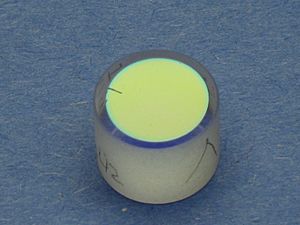
For scientific optical work, dielectric mirrors are often used. These are glass (or sometimes other material) substrates on which one or more layers of dielectric material are deposited, to form an optical coating. By careful choice of the type and thickness of the dielectric layers, the range of wavelengths and amount of light reflected from the mirror can be specified. The best mirrors of this type can reflect >99.999% of the light (in a narrow range of wavelengths) which is incident on the mirror. Such mirrors are often used in lasers.
In astronomy, adaptive optics is a technique to measure variable image distortions and adapt a deformable mirror accordingly on a timescale of milliseconds, to compensate for the distortions.
Although most mirrors are designed to reflect visible light, surfaces reflecting other forms of electromagnetic radiation are also called "mirrors". The mirrors for other ranges of electromagnetic waves are used in optics and astronomy. Mirrors for radio waves (sometimes known as reflectors) are important elements of radio telescopes.
Images for kids
-
4.5-metre (15 ft) high acoustic mirror near Kilnsea Grange, East Yorkshire, UK, from World War I. The mirror magnified the sound of approaching enemy Zeppelins for a microphone placed at the focal point.
-
Detail of the convex mirror from the Arnolfini portrait, Bruges, 1434 AD
-
'Adorning Oneself', detail from 'Admonitions of the Instructress to the Palace Ladies', Tang dynasty copy of an original by Chinese painter Gu Kaizhi, c. 344–405 AD
-
A mirror reverses an image in the direction of the normal angle of incidence. When the surface is at a 90°, horizontal angle from the object, the image appears inverted 180° along the vertical (right and left remain on the correct sides, but the image appears upside down), because the normal angle of incidence points down vertically toward the water.
-
A mirror reflects a real image (blue) back to the observer (red), forming a virtual image; a perceptual illusion that objects in the image are behind the mirror's surface and facing the opposite direction (purple). The arrows indicate the direction of the real and perceived images, and the reversal is analogous to viewing a movie with the film facing backwards, except the "screen" is the viewer's retina.
-
Four different mirrors, showing the difference in reflectivity. Clockwise from upper left: dielectric (80%), aluminum (85%), chrome (25%), and enhanced silver (99.9%). All are first-surface mirrors except the chrome mirror. The dielectric mirror reflects yellow light from the first-surface, but acts like an antireflection coating to purple light, thus produced a ghost reflection of the lightbulb from the second-surface.
-
A dielectric, laser output-coupler that is 75–80% reflective between 500 and 600 nm, on a 3° wedge prism made of quartz glass. Left: The mirror is highly reflective to yellow and green but highly transmissive to red and blue. Right: The mirror transmits 25% of the 589 nm laser light. Because the smoke particles diffract more light than they reflect, the beam appears much brighter when reflecting back toward the observer.
-
Polishing the primary mirror for the Hubble Space Telescope. A deviation in the surface quality of approximately 4λ resulted in poor images initially, which was eventually compensated for using corrective optics.
-
401 N. Wabash Ave. reflects the skyline along the Chicago River in downtown Chicago
-
Grove Of Mirrors by Hilary Arnold Baker, Romsey
-
An illustration from page 30 of Mjallhvít (Snow White) an 1852 Icelandic translation of the Grimm-version fairytale
See also
 In Spanish: Espejo para niños
In Spanish: Espejo para niños



